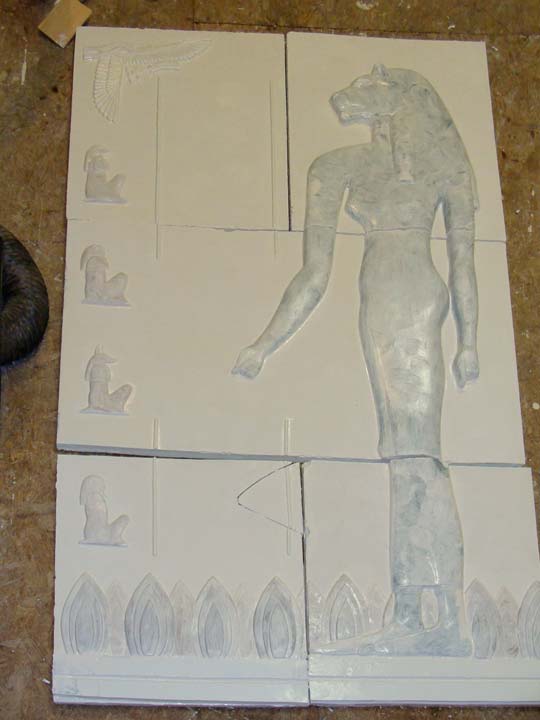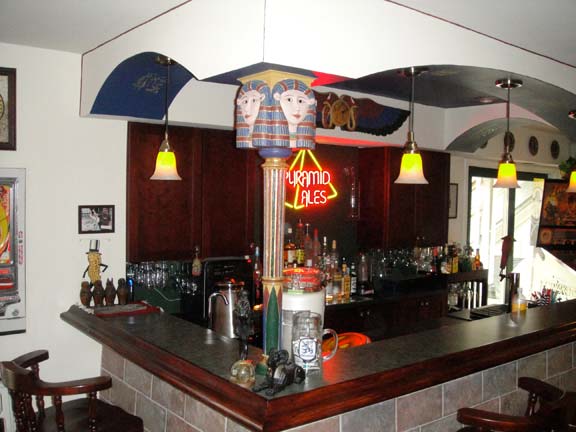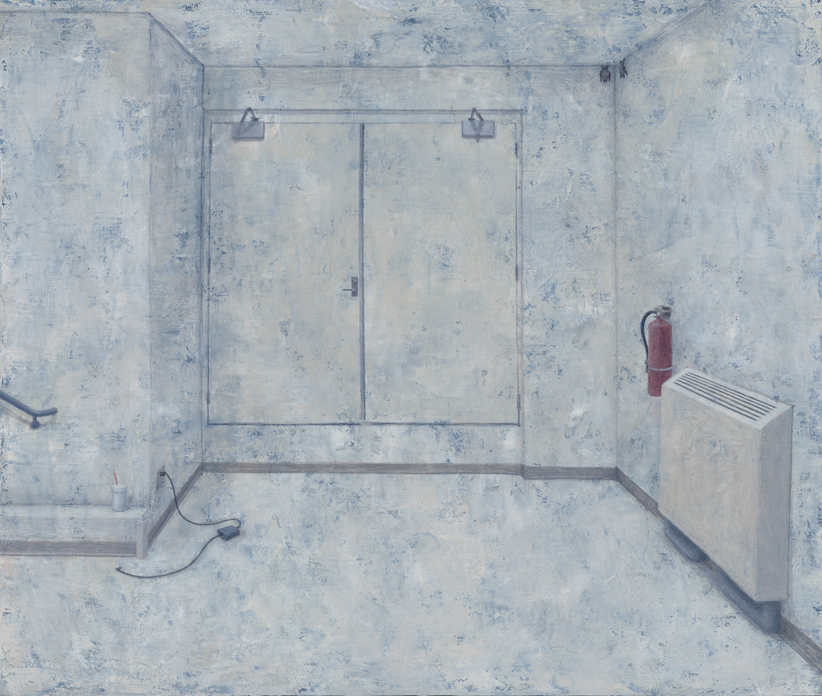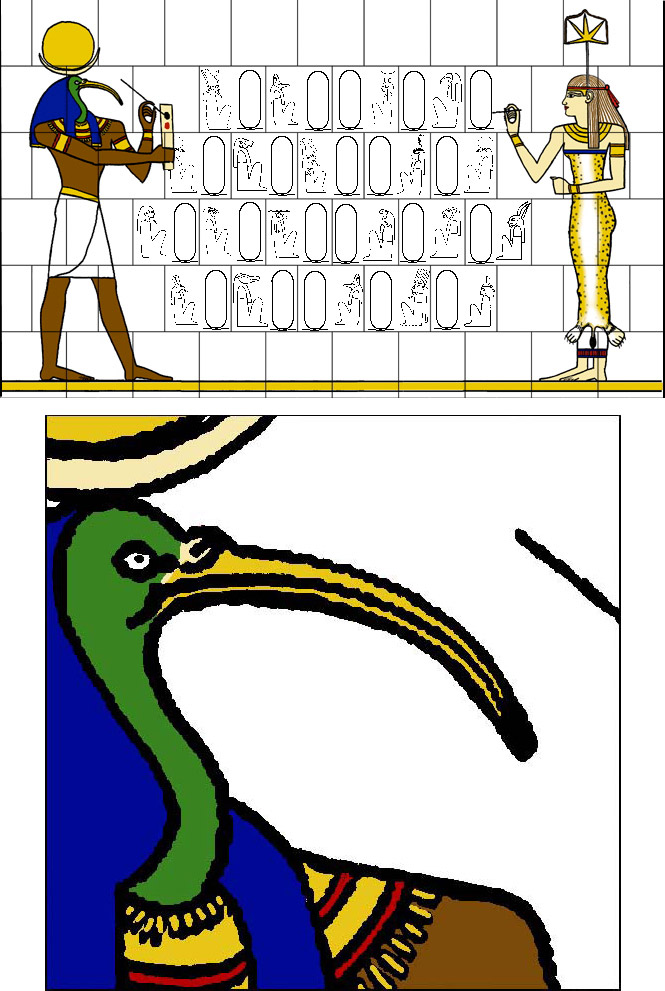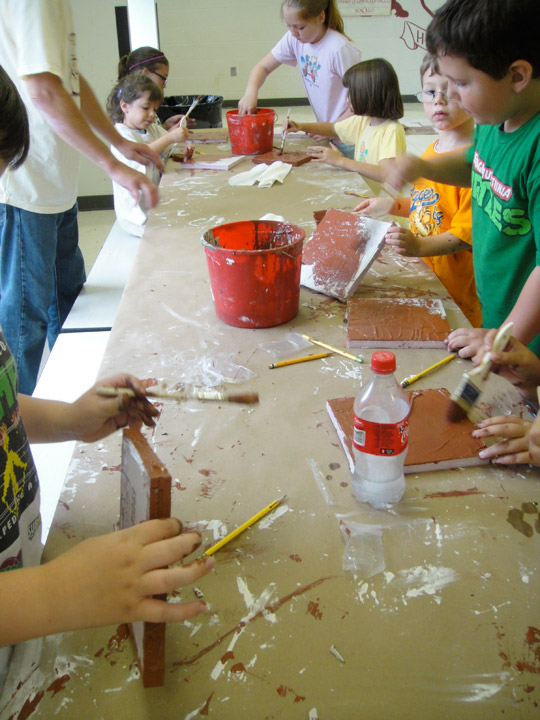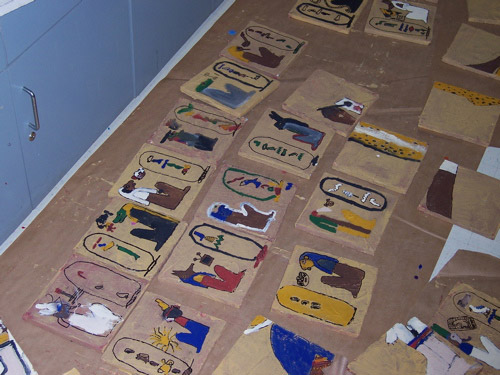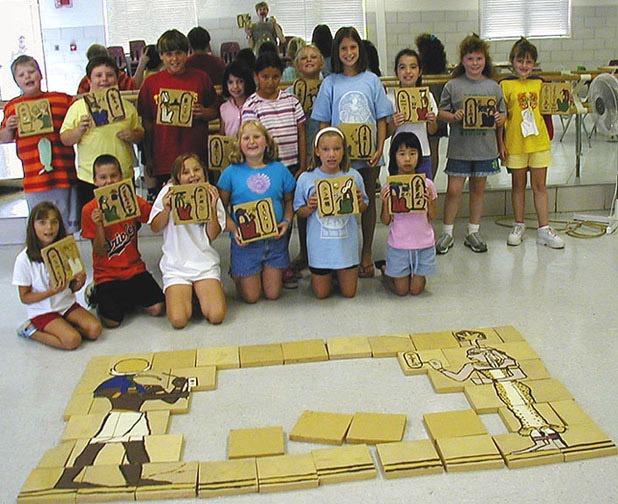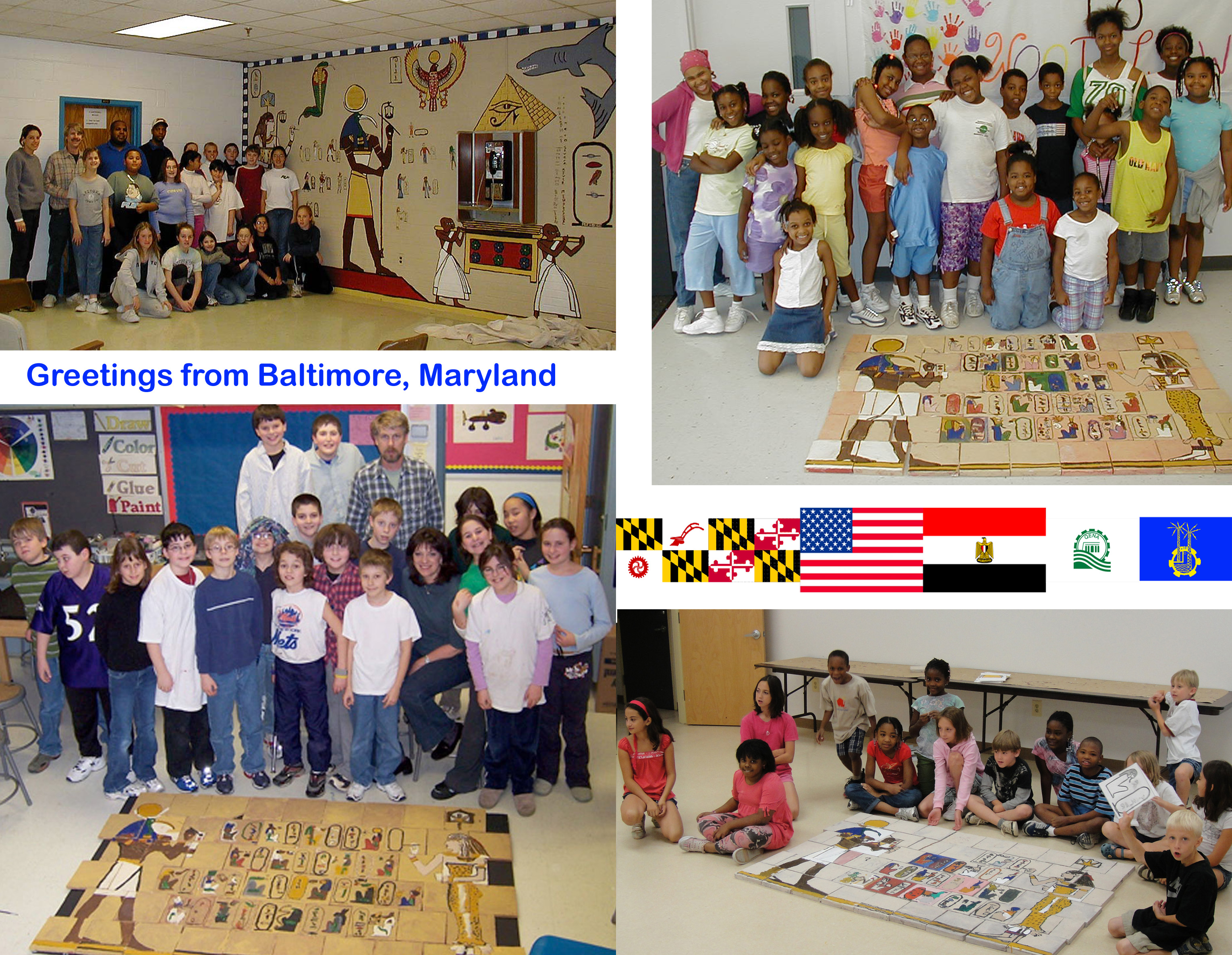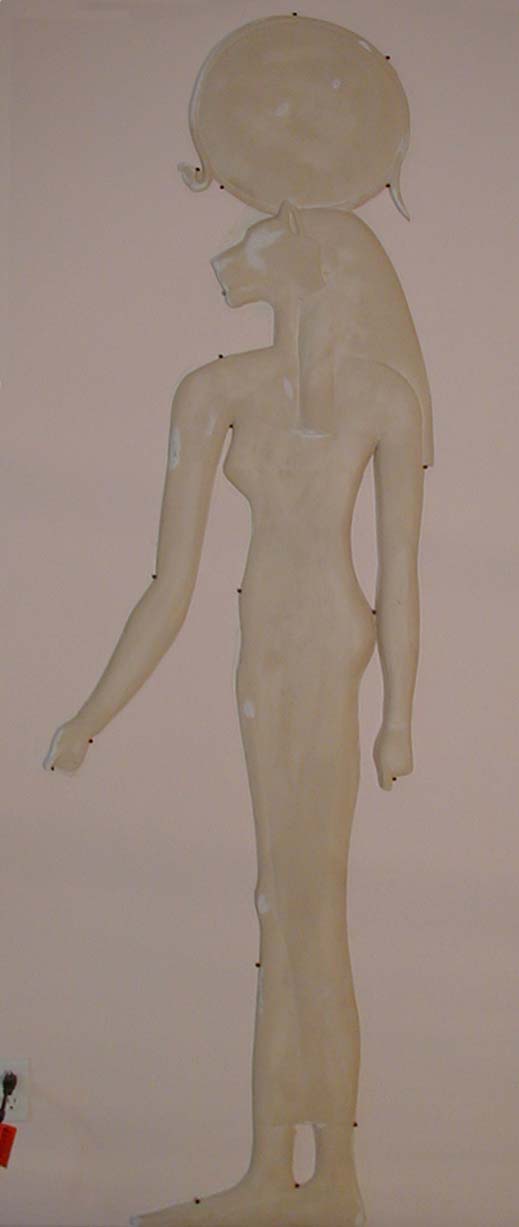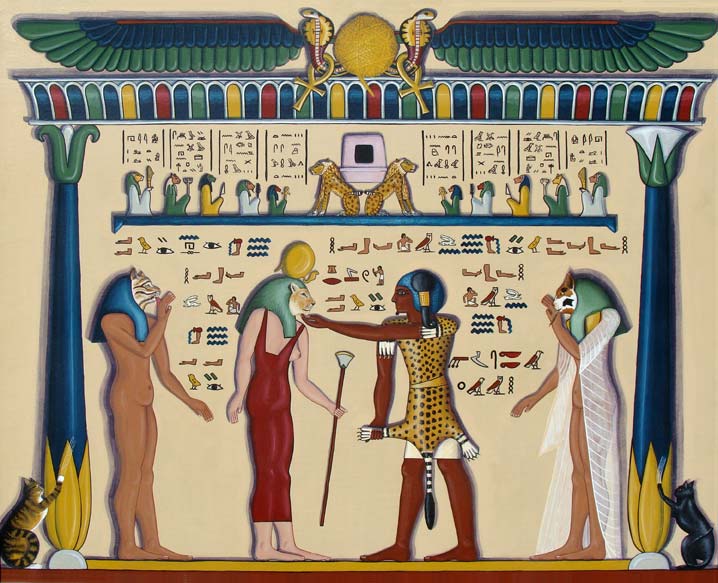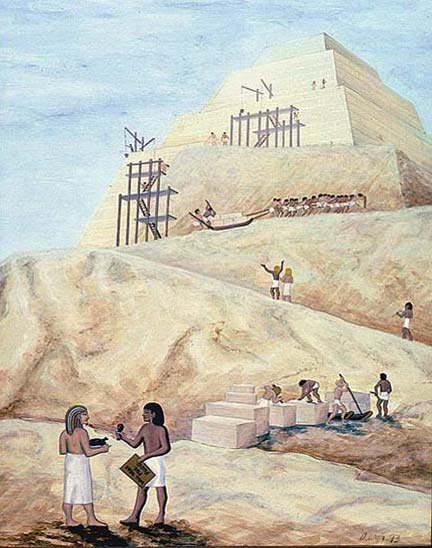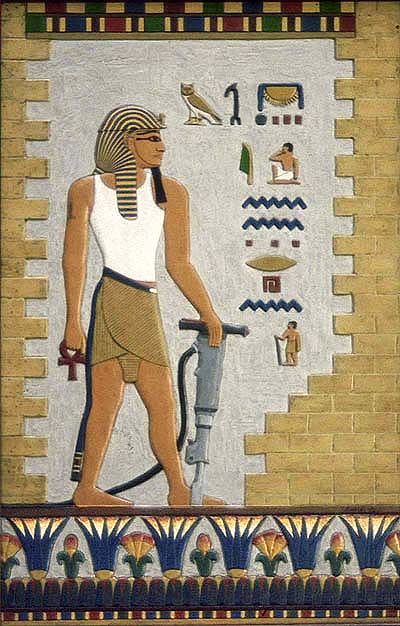About Richard
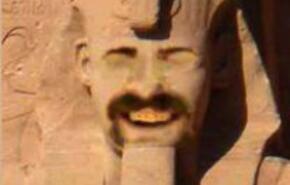
I was born in 1957 in the Garden State of New Jersey (Exit 14a for you locals).
As long as I can remember I have been interested in Ancient Egypt, but I do not know why. I can point to my first coherent memory of something Egyptian. I can even attach a date to it now thanks to the www. It first aired on TV October 2, 1964--a Jonny Quest cartoon, The Curse of Anubis. What an adventure! I was 6 years old and the cobras, scorpions, and walking mummies nearly scared me to death. I was… more
As long as I can remember I have been interested in Ancient Egypt, but I do not know why. I can point to my first coherent memory of something Egyptian. I can even attach a date to it now thanks to the www. It first aired on TV October 2, 1964--a Jonny Quest cartoon, The Curse of Anubis. What an adventure! I was 6 years old and the cobras, scorpions, and walking mummies nearly scared me to death. I was… more
Jump to a project:
<B><font color=#993300 size=+3>Ptolemaic Ptheatre</font></B>
This project involves the designing and finishing of a Media Room. It is the last phase of a much larger project that I have been working on since 1997. That is when I began to finish our basement utilizing an Ancient Egyptian decor. Our basement has become a place to entertain and relax. It is also a place where I can hang my paintings. They blend into the decor when they are at home and they are not conspicuous in their absence.
There was a problem with designing an Ancient Egyptian decor. There was very little available on the market in that style at that time. I could not even find an egyptian style wallpaper. If this was going to work, I would have to make most of the decorations myself. The earlier phases of the project can be found on my web site at:
http://www.egyptartsite.com/pyramidacres.html
The media room is called the "Ptolemaic Ptheatre." It will feature state of the art sound and visual equipment. Movies, TV, and surfing the web will be projected onto a 100" screen. 7.1 surround sound will fill the room from the front, rear, and side walls. Bass shakers installed on the seats will allow the audience to "feel" a movie. Seating will be for a small crowd, eight theater recliners with room to pull in more chairs if the need arises. The seating plan will be tiered on two levels. The upper level "Cleopatra's Balcony" and the lower level, "Caesarean's Section."
The faux-stone blocks making up the bulk of the wall-art are being made with styrofoam panels. I'm casting plaster and a non-toxic resin called Aqua-Resin to make up scenes that mimic Egyptian mythology but with an up to date twist. The gods and goddess on the walls will appear to be involved in a theater goers experience, eating popcorn, sipping soda, wearing 3=D glasses.
Some pieces that I have built for this project like the Cobra Cornice required special consideration. They are numerous, 31 cobras on about 45 linear feet of cornice blocks which measure 10" high by 32" wide and 8" thick. My first concern was that this would take a huge amount of material and it would be costly. Plaster seemed like the most cost effective material to use. My second concern was weight. These plaster pieces had the potential of being very heavy, this made me nervous as they would be hanging over people watching a movie. I needed to mix a plaster which was light weight and also strong. I tried several different mixes before I settled on a mix of ground styrofoam and plaster. The plaster acted as a gel coat to get the detail of the cast and also as a binder for the styrofoam chunks. My fears of a heavy cobra breaking loose, falling, and clunking an unsuspecting movie goer had been laid to rest.
The two side walls of the theater are covered with 6' tall figures of 3 different gods and 3 different goddess striding towards the screen wall. Earlier projects have produced many molds and castings of small and medium glyphs. In these scenes the gods will be depicted handling technical issues such as adjusting the satellite dish or plugging in a coax cable. The goddess will appear to be more interested in watching the movie, carrying a box of popcorn, wearing 3-D glasses and a Mouseketeer hat. Behind the seating on Cleopatra's Balcony will be a rendering of the goddess Maat with her wings outstretched. The ceiling is made to resemble three huge blocks of stone that span the theater from side to side.
The Egyptian decor throughout the rest of the basement is bright and colorful. However, the painting of this room must be muted so as not to be distracting while a movie is playing. Ordinarily, Egyptian wall scenes were carved in low relief without paint, or carved and painted with very bright colors. My plans at this point are to have the room look like carved stone. The bas-reliefs should be enough to bring out the surface details, even in low light. If I find that too much detail is lost, I will paint the scenes in the style that Ramesses the Great employed at Abu Simbal. He had his artists paint the wall reliefs in shades of ochre.
There was a problem with designing an Ancient Egyptian decor. There was very little available on the market in that style at that time. I could not even find an egyptian style wallpaper. If this was going to work, I would have to make most of the decorations myself. The earlier phases of the project can be found on my web site at:
http://www.egyptartsite.com/pyramidacres.html
The media room is called the "Ptolemaic Ptheatre." It will feature state of the art sound and visual equipment. Movies, TV, and surfing the web will be projected onto a 100" screen. 7.1 surround sound will fill the room from the front, rear, and side walls. Bass shakers installed on the seats will allow the audience to "feel" a movie. Seating will be for a small crowd, eight theater recliners with room to pull in more chairs if the need arises. The seating plan will be tiered on two levels. The upper level "Cleopatra's Balcony" and the lower level, "Caesarean's Section."
The faux-stone blocks making up the bulk of the wall-art are being made with styrofoam panels. I'm casting plaster and a non-toxic resin called Aqua-Resin to make up scenes that mimic Egyptian mythology but with an up to date twist. The gods and goddess on the walls will appear to be involved in a theater goers experience, eating popcorn, sipping soda, wearing 3=D glasses.
Some pieces that I have built for this project like the Cobra Cornice required special consideration. They are numerous, 31 cobras on about 45 linear feet of cornice blocks which measure 10" high by 32" wide and 8" thick. My first concern was that this would take a huge amount of material and it would be costly. Plaster seemed like the most cost effective material to use. My second concern was weight. These plaster pieces had the potential of being very heavy, this made me nervous as they would be hanging over people watching a movie. I needed to mix a plaster which was light weight and also strong. I tried several different mixes before I settled on a mix of ground styrofoam and plaster. The plaster acted as a gel coat to get the detail of the cast and also as a binder for the styrofoam chunks. My fears of a heavy cobra breaking loose, falling, and clunking an unsuspecting movie goer had been laid to rest.
The two side walls of the theater are covered with 6' tall figures of 3 different gods and 3 different goddess striding towards the screen wall. Earlier projects have produced many molds and castings of small and medium glyphs. In these scenes the gods will be depicted handling technical issues such as adjusting the satellite dish or plugging in a coax cable. The goddess will appear to be more interested in watching the movie, carrying a box of popcorn, wearing 3-D glasses and a Mouseketeer hat. Behind the seating on Cleopatra's Balcony will be a rendering of the goddess Maat with her wings outstretched. The ceiling is made to resemble three huge blocks of stone that span the theater from side to side.
The Egyptian decor throughout the rest of the basement is bright and colorful. However, the painting of this room must be muted so as not to be distracting while a movie is playing. Ordinarily, Egyptian wall scenes were carved in low relief without paint, or carved and painted with very bright colors. My plans at this point are to have the room look like carved stone. The bas-reliefs should be enough to bring out the surface details, even in low light. If I find that too much detail is lost, I will paint the scenes in the style that Ramesses the Great employed at Abu Simbal. He had his artists paint the wall reliefs in shades of ochre.
-
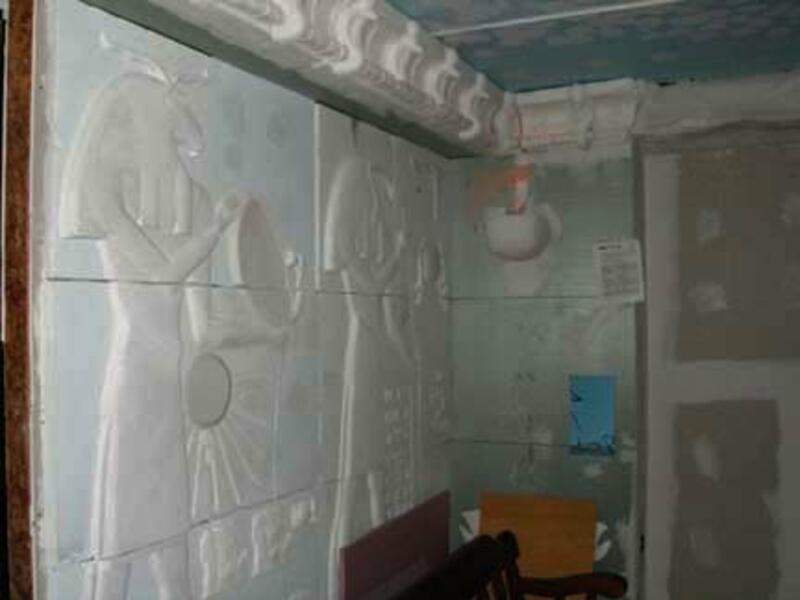 <B>Gods on the Wall</B><BR>2010
<B>Gods on the Wall</B><BR>2010
Panels installed in the theatre. The ram-headed god Khnum is adjusting the satellite reception while the Ibis-headed god Thoth is looking for a place to plug the coax cable. In front of them is a torch utilizing faux flame lighting. The cobra cornice also figures into the mood-lighting plan. Rope light runs around the base of the cobras. -
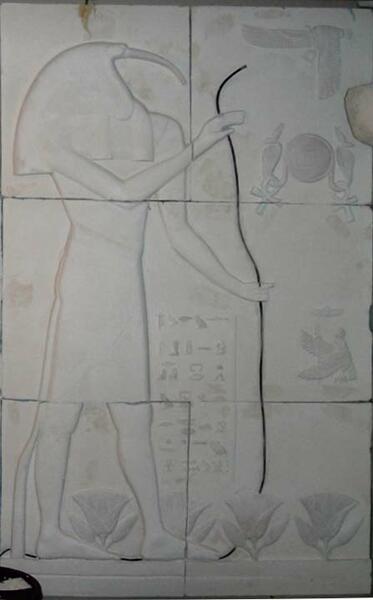 <B>Thoth</B><BR>2010
<B>Thoth</B><BR>2010
Detail of the ibis-headed god Thoth vignette. -
 <B>Wadjet on a stick</B><BR>2010
<B>Wadjet on a stick</B><BR>2010
A Styrofoam carving of the winged serpent Wadjet flanks the front speaker cabinet. -
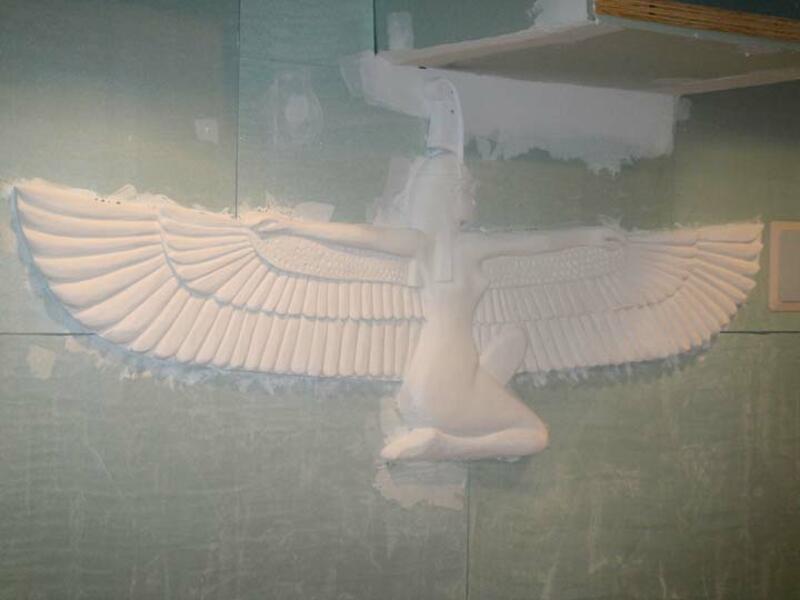 <B>Winged Maat</B><BR>2010
<B>Winged Maat</B><BR>2010
The goddess of truth, justice and the Egyptian way. This is carved styrofoam after spackeling, sanding, and priming. It is 42" x 24" x 2" This is an original carving, I will now pull a mold from it. That will allow me to have this image available for future projects. -
 <B>Pieces parts</B><BR>2010<BR>
<B>Pieces parts</B><BR>2010<BR>
If you have been to Egypt you know that the ancients wrote on every inch of a wall, everything was covered. It is my goal to achieve an authentic feeling Egyptian decor. I will need to cover a great deal of wall space with these small and mid-sized castings that I have made over the years for other projects. They will be added to panels to help approximate the level of detail used by the ancients. -
 <B>Goddess Sekhmet panel</B><BR>2010<BR>
<B>Goddess Sekhmet panel</B><BR>2010<BR>
Sekhmet, lioness goddess of war. This scene is made from a 4 x 8 foot styrofoam panel. Cut to mimic stone blocks. Each block has different small and medium castings added. The final touches on this panel will be the addition of hieroglyphic writing in which I try to say something with the hieroglyphs. It never ceases to amaze me that some people have learned to read hieroglyphs. I have had people come to me at my shows and correct what I have written in glyphs, on a painting. -
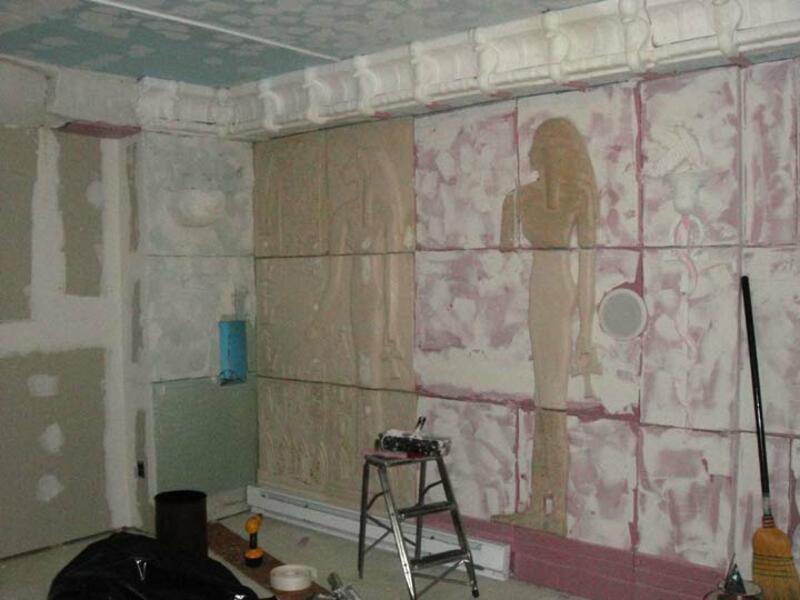 <B>Wall of goddess's</B><BR>2010<BR>
<B>Wall of goddess's</B><BR>2010<BR>
The right side of the room features goddess. -
 <B>Mood lighting</B><BR>2010<BR>
<B>Mood lighting</B><BR>2010<BR>
When you enter the theater it will be lit by these faux flame and the cobra cornice rope lighting. This will give the feeling of a dimly lit temple. When this area is painted it will appear to be heavily damaged by smoke on the wall, the cornice, and the ceiling. -
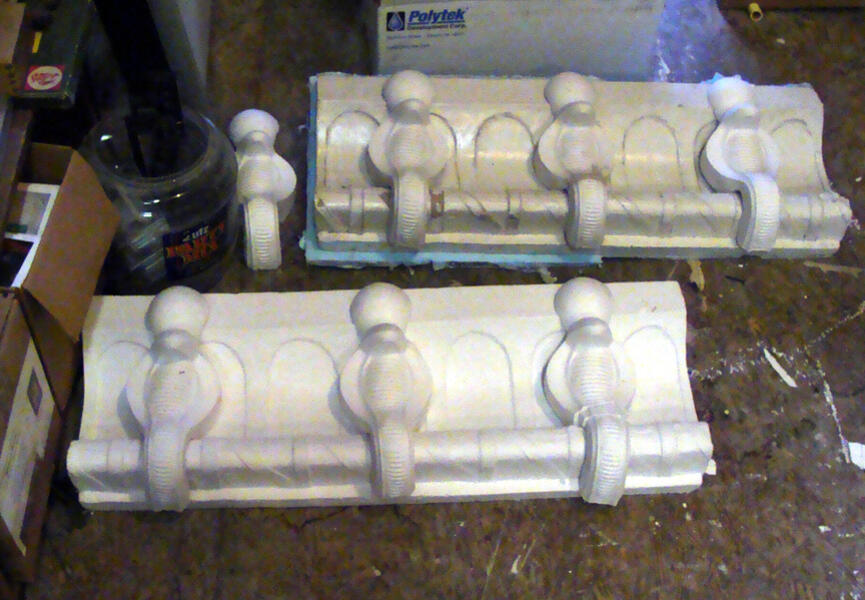 <B>Cobra Cornice Blocks</B><BR>2010<BR>
<B>Cobra Cornice Blocks</B><BR>2010<BR>
Each cornice block measures 10" high by 32" wide and 8" thick. There are 14 blocks that make up the 45 linear feet of cornice. -
 <B>Cobra Cornice</B><BR>2010<BR>
<B>Cobra Cornice</B><BR>2010<BR>
The Cobra Cornice is dimly lit using rope lighting. There are 31 of these cobras around three-quarters of the room. The forth wall is where the movie screen will be. The cornice on the forth wall will appear to have broken and fallen. No lights, no cobras to interfere with the screen which will be on that wall. The cornice is made from plaster and ground styrofoam bits to reduce the weight. The cobras and the cornice blocks were cast separately. Broken and cracked pieces will add to the overall feeling of antiquity.
<B><font color=#993300 size=+3>Pyramid Acres</font></B>
Egyptian Decor: Finished basement.
In 1997 we bought a house with 1650 sq. ft. of unfinished basement. We decided to make it an Egyptian decor. A place where I could hang my paintings when they were not hanging elsewhere.
So, Egyptian decor! Where do we buy that?
When we started this project there were very few options for Egyptian decor available on the market. I decided I would need to create my own. As the project has moved along more Egyptian style furnishings have become available. Our basement is now a collection of my work, store bought furnishings and Egyptian knickknacks. I am having a great time with this project.
In 1997 we bought a house with 1650 sq. ft. of unfinished basement. We decided to make it an Egyptian decor. A place where I could hang my paintings when they were not hanging elsewhere.
So, Egyptian decor! Where do we buy that?
When we started this project there were very few options for Egyptian decor available on the market. I decided I would need to create my own. As the project has moved along more Egyptian style furnishings have become available. Our basement is now a collection of my work, store bought furnishings and Egyptian knickknacks. I am having a great time with this project.
-
<B>Clip from HGTV Special</B><BR><BR>Ten Hours of filming produced six minutes of TV air time.
-
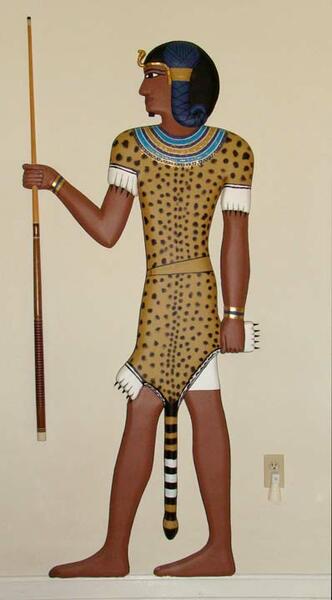 <B>Priest at the Pool Table.</B><BR>Sheetrock bas-relief<BR> 2000
<B>Priest at the Pool Table.</B><BR>Sheetrock bas-relief<BR> 2000
Three layers of ½" sheetrock spackled, sanded, and painted. I am very happy with the results that I was able to achieve with this technique. The problem I have with this sculpture and the Anubis sheetrock sculpture is that they are now a permanent part of the wall, they can never be moved. -
 <B>Anubis</B><BR>Sheetrock bas-relief.<br>2000
<B>Anubis</B><BR>Sheetrock bas-relief.<br>2000
Three layers of ½" sheetrock spackled, sanded, and painted. This poor dog will never be allowed to go out. He would crumble into broken sheetrock and spackle dust. Anubis and the Priest are permanent fixtures guarding our pool table. -
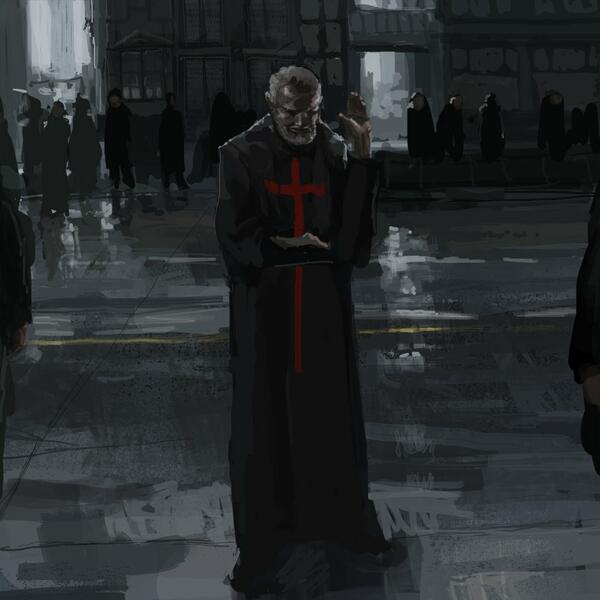 PriestDigital
PriestDigital -
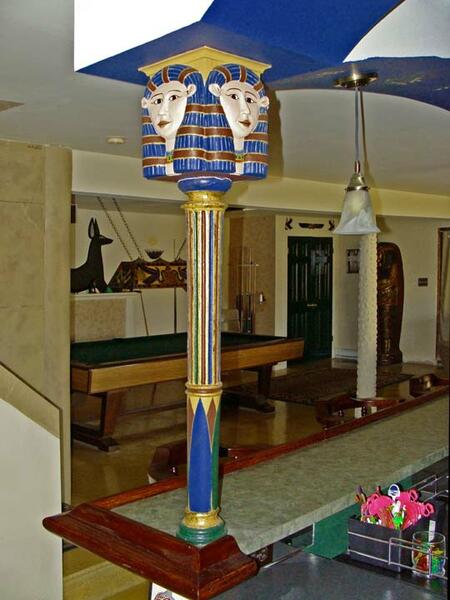 <B>Hathor Column</B><BR>Cast plaster, wood, and paint.<BR>2001<BR>
<B>Hathor Column</B><BR>Cast plaster, wood, and paint.<BR>2001<BR>
The bottom portion of these columns is made from wooden pillars that once decorated a fireplace mantle in a Charles Village home. On the top of the column is the head of goddess Hathor. Hathor was the goddess of music and love, seems appropriate to find her in a bar. Hathor Columns were common in ancient Egypt -
 <B>Hathor over looks the bar.</B><BR>2000<BR>
<B>Hathor over looks the bar.</B><BR>2000<BR> -
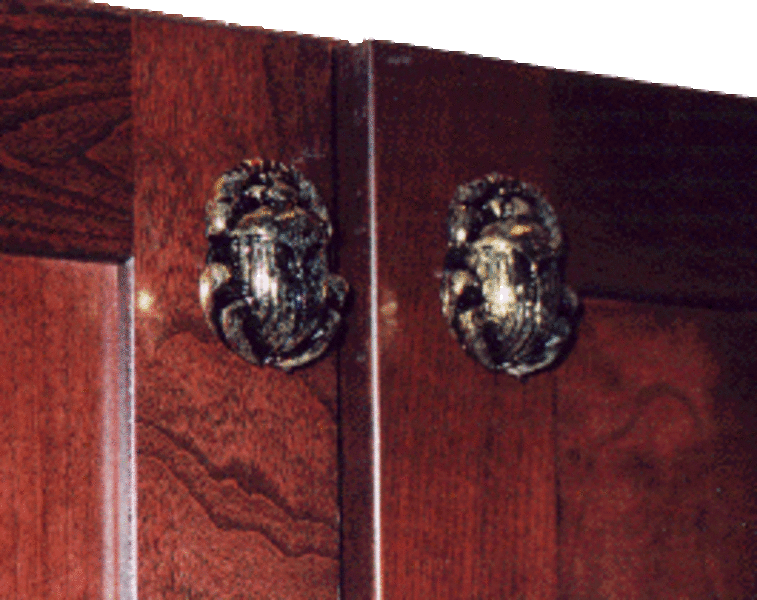 <b>Scarab door pulls</B><BR>
<b>Scarab door pulls</B><BR>
The cabinets in our bar are made of cherry. We could not find any door pulls that seemed appropriate for the Egyptian theme so I made these small scarab knobs. -
 <B>The Bar Clock</B><BR>Acrylic on Cast Aqua-Resin.<BR>
<B>The Bar Clock</B><BR>Acrylic on Cast Aqua-Resin.<BR>
The bar clock was inspired by the clock that I had painted in 1:47 B.C. Last Call. -
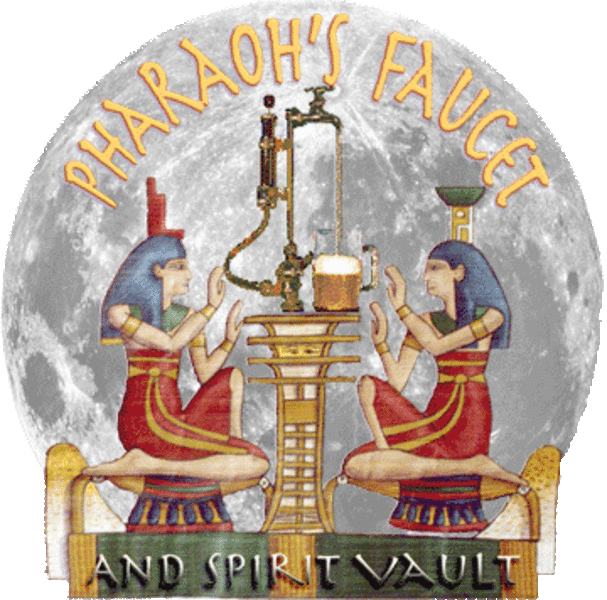 <b>Pharaoh's Faucet</b><BR>
<b>Pharaoh's Faucet</b><BR>
Our beer tap has a first name. It's O S C A R.
No, it's not. It's Pharaoh's Faucet. -
 <B>Our Faucet Handle</B>
<B>Our Faucet Handle</B>
Thanks to Al Gore's internet almost anything is possible. If you had asked me ten years ago, "Do you know anyone that makes custom beer taps?" I would have drawn a blank. Now I'd say, "Google it."
<B><font color=#993300 size=+2>Pyramid Acres II</B></font>
-
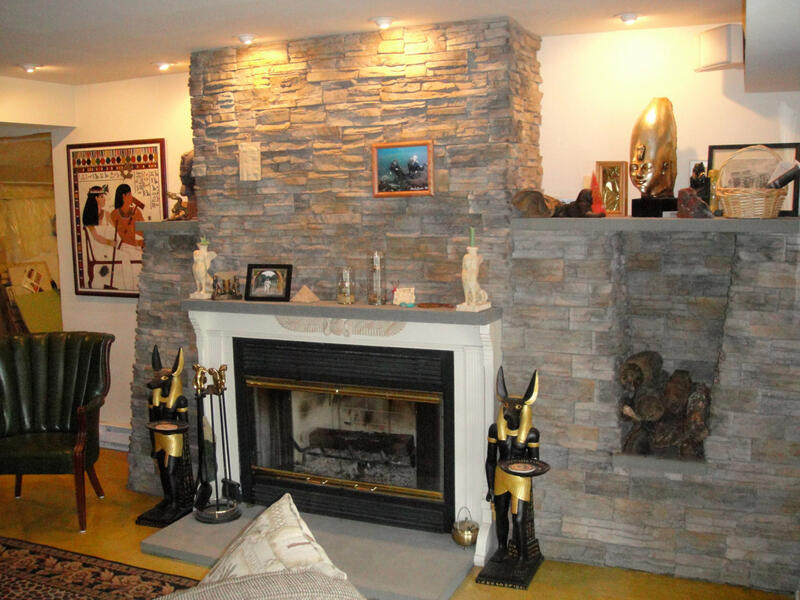 <B>Fireplace</B><BR>
<B>Fireplace</B><BR> -
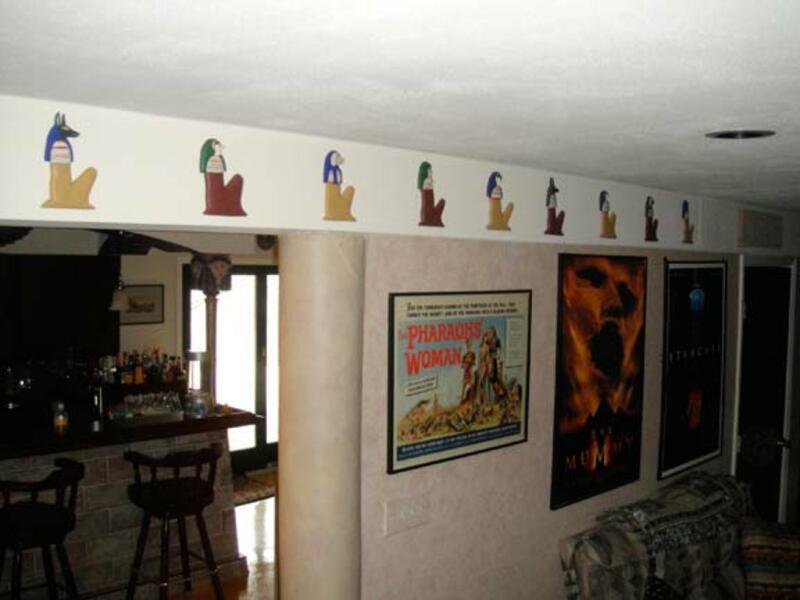 <B>Old theater</B><BR>
<B>Old theater</B><BR>
Small castings of different gods decorate a bulkhead in the old (soon to be closed) theater. In the future this room is slated to become an arcade. We will move our pinball machine into here and see what other egyptian themed games we can find.
http://www.egyptartsite.com/indy.html -
 <B>Stairwell</B><BR>
<B>Stairwell</B><BR>
Inspired by the Grand Gallery of the Great Pyramid at Giza. -
 <B>The Isis Column</B><br>2006
<B>The Isis Column</B><br>2006
Inside this wooden column is the steel post that is typical in basement construction. I got the wooden column from a porch demolition in Hamden. I split the column in two and then glued it around the steel post. I added the small hieroglyphs, and it will be paint to mimic sandstone. -
 <B>Lotus Column</B><BR>1999This column made using Sonotubes, large cardboard tubes normally used as concrete forms. The capital was made from wire mesh covered with shaped plaster.
<B>Lotus Column</B><BR>1999This column made using Sonotubes, large cardboard tubes normally used as concrete forms. The capital was made from wire mesh covered with shaped plaster. -
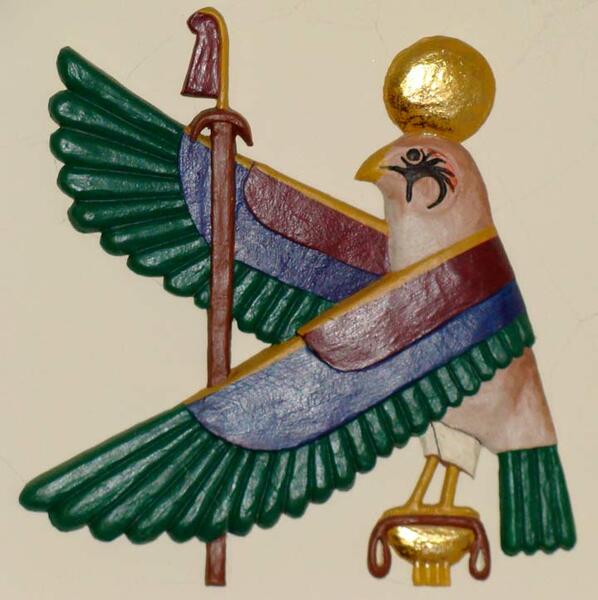 <B>Golden Horus</B><BR>Acrylic on Aqua-resin
<B>Golden Horus</B><BR>Acrylic on Aqua-resin
The god horus as a medium sized casting. He can be found in many places throughout this project. -
 <B>A Glyph Panel</B>
<B>A Glyph Panel</B>
This is two of the three different sized glyphs that I am working with. This is an example of the small and medium glyphs. The large glyphs are the 6' tall Bas-relief. -
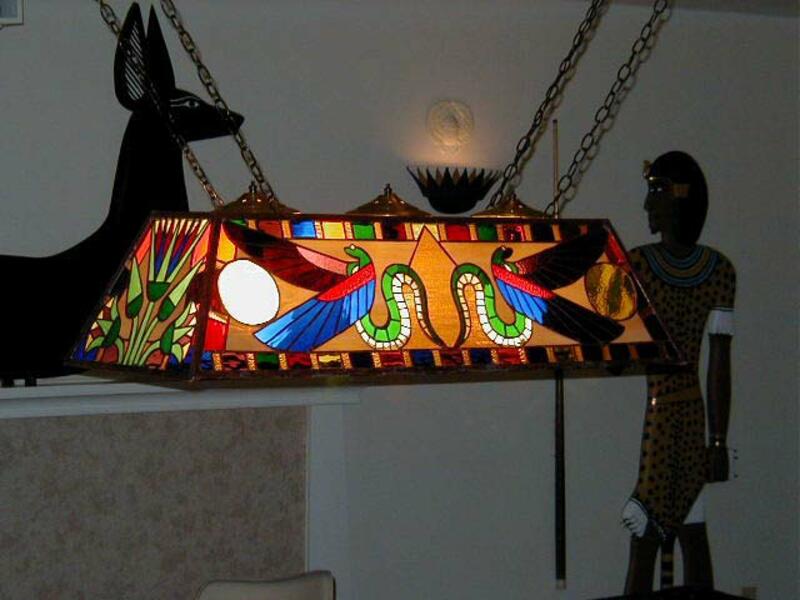 <B>Pool Table Light</B>
<B>Pool Table Light</B>
My design, my brother's stained glass handiwork. -
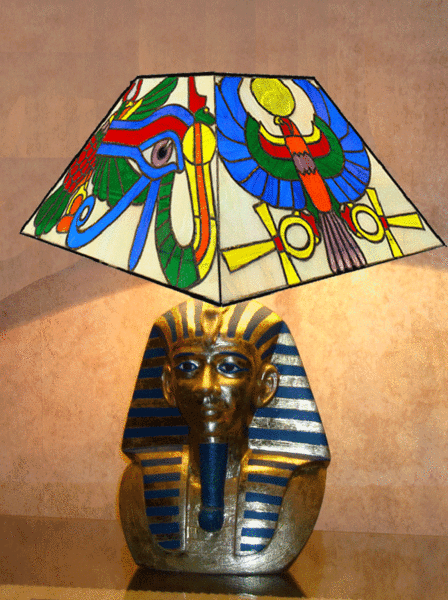 <B>King Tut Table Lamp</B><BR>2006
<B>King Tut Table Lamp</B><BR>2006
I am always on the lookout for good quality reproductions. I had seen several small King Tut Table Lamps on the market. They were made of plastic and did not look much like King Tut. But they did look cheap.
I built my own. Seen here with the stained glass design for the lamp shade.
<B><font color=#993300 size=+3>Egyptian Murals</font></B>
Sometimes I think that my desicion to be an artist is the most selfish thing I could have done with my life. It is a very time consuming occupation, time lost from family, friends, and community. And in the end I have created things that most people put very little value on. But then there are opportunities like these mural projects that have given me a chance to make a difference in peoples lives.
My first mural was commissioned by Baltimore County Commission on Arts and Science. I was asked to produce a mural that could travel and be displayed in different areas of the county. I would meet with 16 children for 45 minutes a day for 5 days. Unlike most murals this one would have to be portable. Lightweight and small enough to be transported. At the time I was using styrofoam to create faux stone in my own work. So it was not hard to consider building murals out of styrofoam, it would certainly be lightweight. I decided a 4' x 8' styrofoam panel would be a good size to transport.
I tell the children this:
"The year is 2010 BC. The Pharaoh Mentuhotep II has just begun his rule as King of the world, Bull of bulls, Son of Horus. To celebrate he as brought together his greatest scribes to commemorate the occasion. We are the scribes that will be building this mural.
We work for Pharaoh!"
My first mural was commissioned by Baltimore County Commission on Arts and Science. I was asked to produce a mural that could travel and be displayed in different areas of the county. I would meet with 16 children for 45 minutes a day for 5 days. Unlike most murals this one would have to be portable. Lightweight and small enough to be transported. At the time I was using styrofoam to create faux stone in my own work. So it was not hard to consider building murals out of styrofoam, it would certainly be lightweight. I decided a 4' x 8' styrofoam panel would be a good size to transport.
I tell the children this:
"The year is 2010 BC. The Pharaoh Mentuhotep II has just begun his rule as King of the world, Bull of bulls, Son of Horus. To celebrate he as brought together his greatest scribes to commemorate the occasion. We are the scribes that will be building this mural.
We work for Pharaoh!"
-
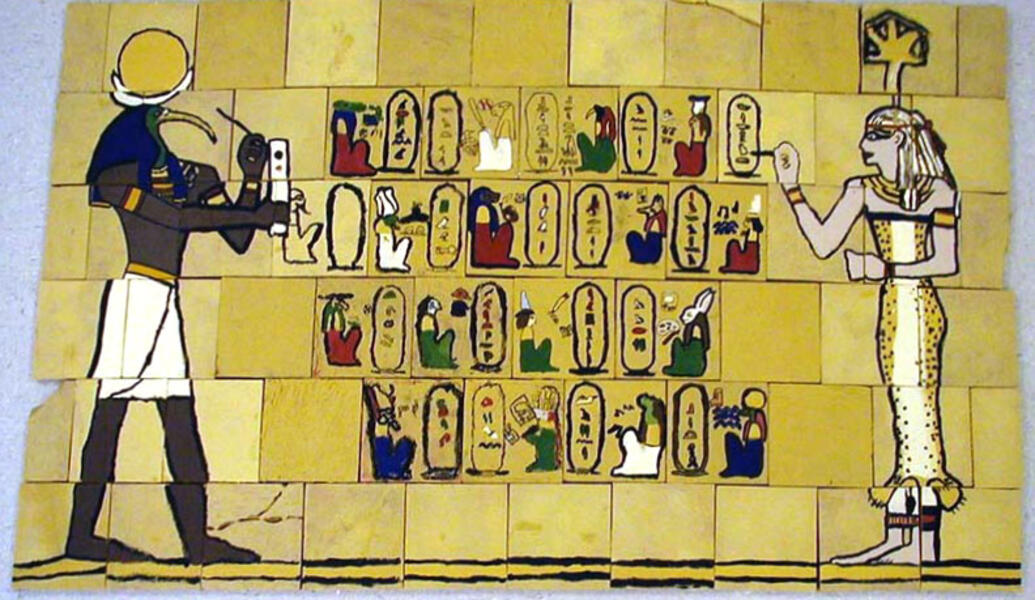 <B>An Egyptian Mural</B>
<B>An Egyptian Mural</B>
The Egyptians painted huge figures on giant blocks of stone. We would make a similar image on a much smaller scale. If we cut the mural into blocks it would serve several purposes. First, they would mimic stone blocks. And second, it would allow each child to work on a piece of the mural without having to work on top of each other in a small 4' x 8' space. The blocks created a grid in which my small drawing could be blown up to the mural size. Each 1" square of my drawing would be an 8" square on the mural. -
 <B>Mural Drawings</B>
<B>Mural Drawings</B>
A very simple design. Above is the layout of the 8" x 8" blocks with the ibis-headed god Thoth and his consort, Seshat. Both represent the scholarly pursuits like reading, writing, and arithmetic. They seem a good fit for working in MD schools.
The bottom photo is the drawing of Thoth's face as an individual block. It is from drawings like this that the children will work to create the larger images that make up the mural. They will need to transfer and than paint this onto our faux stone blocks. -
 <B>Building Blocks</B>
<B>Building Blocks</B>
The project begins by making our 8" square blocks of styrofoam into faux stone. First we apply a thin coat of spackle to give us some surface texture. Than the blocks are put away to dry over night. The next step is to paint our blocks a dark brown color to act as our undercoat. Again the blocks are put somewhere to dry. The final layer is painted with yellow ochre, transparent medium, and sanded tile grout. The transparent medium allows some undercoat to show through in places, giving the blocks depth. While the sanded tile grout adds a fine texture. After two days our faux stone production line has produced about 60 stones.
A very interesting thing happens at about this time in these mural projects. The children have become possessive of their blocks. They applied spackle, let dry. They pick up the same stone, paint it with dark brown undercoat, let it dry. Again, they pick up the same stone. Apply the finish yellow ochre coat, let it dry. Now we are ready to transfer our drawings onto the stones. Again, they go to the pile and pick up the same stone. They are quite proud of them. Some who were disbelievers when I told them we would make styrofoam look like stone, now readily admit that they look pretty good.
I say "Pass your stone to the person on your right."
Moans and groans, a clammer erupts.
"NO! This is my stone!"
"No, I say, these are Pharaoh's stones."
Eventually they agree and pass the stones.
Breaking this bond of possession is the first step in learning to work together as a team. I remember at the end of one project a little girl was showing her mom the finished mural.
The mom asked. "How in the world did you do all this in one week?"
With great pride the little girl replied "We worked together." It was that moment that I realized how important this lesson is. Most children don't learn to work together at that age, if ever. -
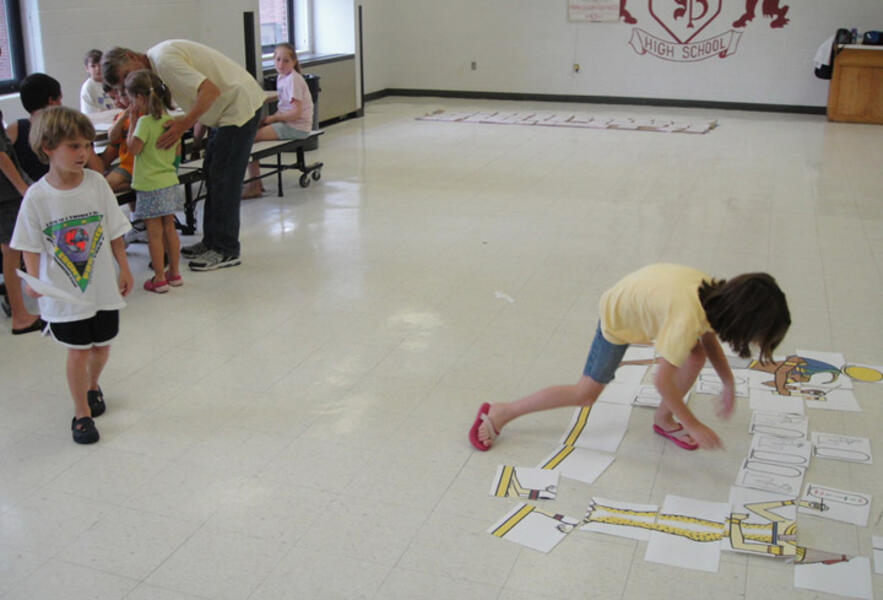 <B>Pharoah's Workers</B>While we wait for our faux stone blocks to dry we stay busy with the design of the mural. We talk about the project and how we will accomplish it. I encourage as much participation as the kids are willing to give. The project is discussed in such a way as to allow the children to believe that they are the ones that are planing and controlling its outcome. They are Pharaoh's scribes and they like it.
<B>Pharoah's Workers</B>While we wait for our faux stone blocks to dry we stay busy with the design of the mural. We talk about the project and how we will accomplish it. I encourage as much participation as the kids are willing to give. The project is discussed in such a way as to allow the children to believe that they are the ones that are planing and controlling its outcome. They are Pharaoh's scribes and they like it.
Orders come down from Pharaoh.
"Pharaoh is so pleased with the progress of the mural project that Pharaoh has demanded that a likeness of each of his scribes be included on the mural with their names written in the finest hieroglyphs."
And so we learn to translate our names from english into ancient egyptian hieroglyphs. -
 <B>Building Blocks</B>
<B>Building Blocks</B>
Here are some of the blocks which the children have written their names on. The elliptical shape is called a cartouche. According to Egyptian myths a name is written inside a cartouche to protect it for eternity. Also on these blocks the children have selected a god or goddess to represent them. By now the kids have learned that we are using symbols. The hieroglyphs are symbols that represent sounds that letters make. While an image of a god can represents an idea like truth, justice, and balance. I now ask the children to make up their own symbol to represent something they like to do. Shopping, sports, playstation are all popular symbols that they have used.
The block towards the center of this photo features the jackal-headed god Anubis wearing red. The hieroglyphs in the cartouche spell the name Ben. The symbol that Ben has drawn to represent what he likes to do sits between Anubis and the cartouche. It looks like a TV. This stone tells us that Ben likes to watch TV.
Again we find our selves waiting for paint to dry. But again this is not waisted time. I encourage the children to tell the stories that they know about ancient Egypt, and I share a few myself. -
 <B>The fun of learning.</B>
<B>The fun of learning.</B>
On this project my job is very easy. It is to allow these kids to have fun. Maybe it's just me but, the things I remember from being that age are the things I learned while having fun. Those are the things that are still with me, the rest is a blur. -
 <B>An Egyptian Mural</B>
<B>An Egyptian Mural</B>
It never ceases to amaze me the quality of work that children are capable of. Some of these children have never had the opportunity to hold a paint brush let alone use one. Most say, "I can't." Well, of course they can, all they need is a little direction and encouragement.
I'm sure I'm preaching to the choir when I say: "Shame on our society for allowing the arts to become forgotten in our schools, we are losing track of creative thought and decision making one generation at a time." -
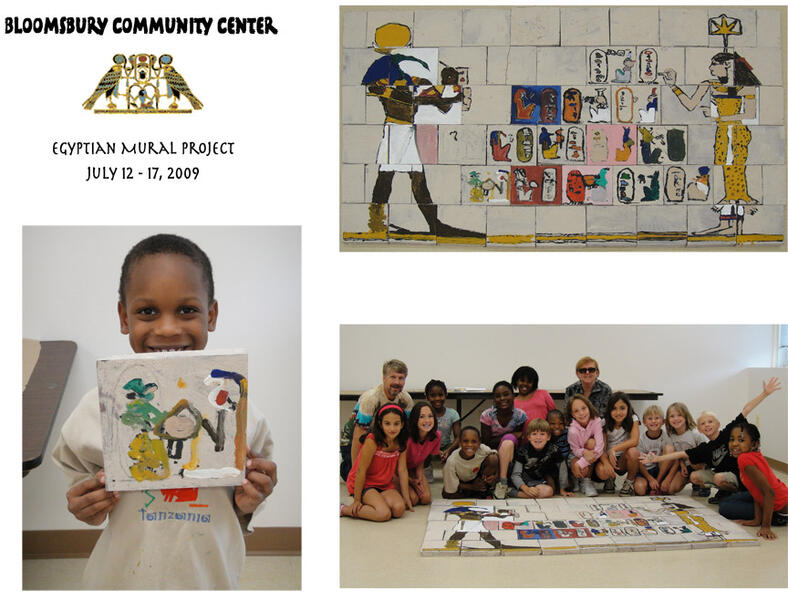 <B>Something to Remember</B>
<B>Something to Remember</B>
Some of these murals get hung and some don't. If the mural stays intact than the children have nothing to take home as a memento. So every mural project I put together a photo montage for each child. It may not be important now but someday they will have this photo to spark their memories. -
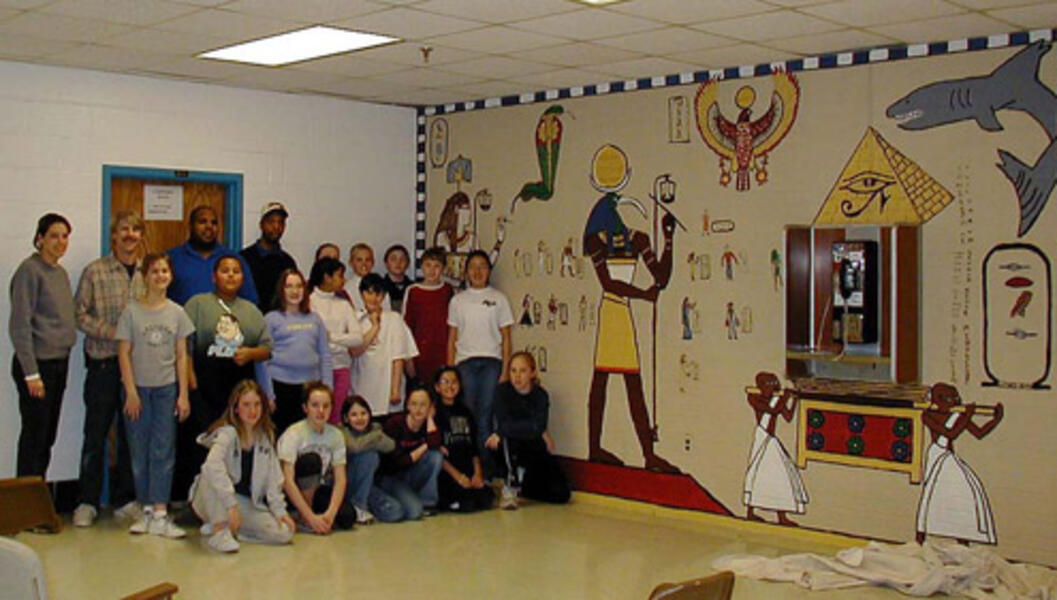 <B>A Different Kind of Mural</B>
<B>A Different Kind of Mural</B>
This is a more conventional mural painted on a wall, it is a permanent fixture. The schools mascot is the Sharks. -
 <B>Murals Across the World</B>
<B>Murals Across the World</B>
In 2009 I had the opportunity to visit an Experimental School in Luxor, Egypt. Experimental in that they are teaching english. Girls and boys are also allowed to attend the same classes. Both of which are huge accomplishments in their world. Our group brought many things to help the school in their efforts, pencils, paper, and other supplies. I brought some of these pictures so that they could see what American school children looked like. But what they enjoyed most of all was to high-five a blonde American. I high-fived every kid in the school. I was delighted, they were enthralled.
<B><font color=#993300 size=+3>A Baltimore Basement</font></B>
This project began as a chance meeting. I was leaving a Young Audience's charity event when I found myself standing in a line with someone whom had purchased one of my lithographs in the silent auction. She told me of her love for all things Egyptian and the collection of art she had at home. It turns out that this was not the first of my pieces that she had bought. She asked me if I would be interested in painting a mural in her basement, I told her I could do better than a mural. I could create a three dimensional work of art. So work began.
-
 <B>Before Construction</B><BR>2004
<B>Before Construction</B><BR>2004
This is the basement area in which the homeowner wanted to create an Egyptian decor. It was more or less an empty basement used to store odds and ends. I must say, I did have trouble moving the Johnny Unitas painting from its place of honor. With the goal of achieveing an Egyptian decor, Johnny could not stay unless he could become a pharaoh.
There were problems with this project that would need to be overcome. First, this was a huge space on a small budget. What I could do would be limited. The rest of the decor would need to be finished "off the shelf." Secondly, the color scheme was not what I would have chosen. The floor was pink granite and the walls were pastel pink. Neither of which could be changed. -
 <B>My portion of the project finished. </B><BR>2004
<B>My portion of the project finished. </B><BR>2004
This picture shows the two figures that I created. Thoth and Sekhmet are 8 feet tall from their feet to the top of their crown. They were cast in my studio using aqua-resin. Transport was somewhat challenging because of their size and the fact that their extremities were very fragile. They were installed using adhesive caulk. Spackle and caulk were added to cover any gaps between the pieces and the wall. They were painted using interior house paint. -
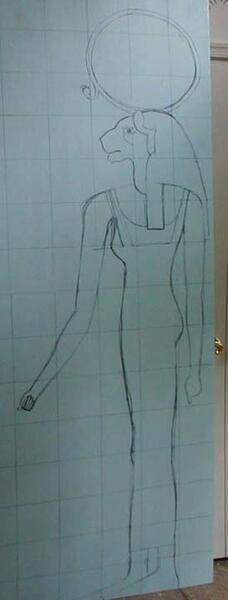 <B>Sekhmet drawn on foam</B>
<B>Sekhmet drawn on foam</B>
The ancient egyptians employed a grid system when they were drawing the figure. One grid equaled certain body parts, like the length of a hand or the length of a face to the hair line. By doing this they were able to maintain proportions no matter if a figure was a small glyph or a giant scene on a temple facade. Today, mural artist are familiar with this technique but may not know that it's roots are in ancient Egypt. -
 <B>Sekhmet Installed</B>
<B>Sekhmet Installed</B>
After carving the foam into a finished original. Polyurethane rubber is brushed on to make mold from which I can cast many duplicates. In this case it is made from aqua-resin, which is a water based, non-toxic casting media. This figure is life size, 6 feet tall to the tip of her ear. That makes weight and material costs a consideration. This figure is a hallow shell. 3 layers of aqua-resin are used. First a thin surface coat is applied to create what will be the outside surface with all the detail of the original. Subsequent layers are used with a reinforcing material, I use burlap. The finished product is thin, light and strong. -
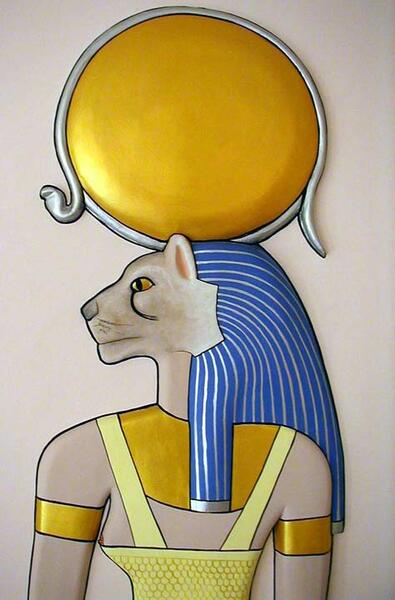 <B>Sekhmet Painted.</B>
<B>Sekhmet Painted.</B>
Working in three dimensions allows for details that a 2-D painting does not. For instance the whiskers on Sekhmet's face are made from heavy guage fishing line. -
 <B>Thoth Carved in Foam</B><BR>2004
<B>Thoth Carved in Foam</B><BR>2004
The Ibis-headed god Thoth was the god of reading, writing, and arithmetic. He wears a crown representing the phases of the moon from crescent to full. This is the original carved styrofoam, spackled, sanded and primed. It is now ready to be covered with polyurethane rubber to create a mold. -
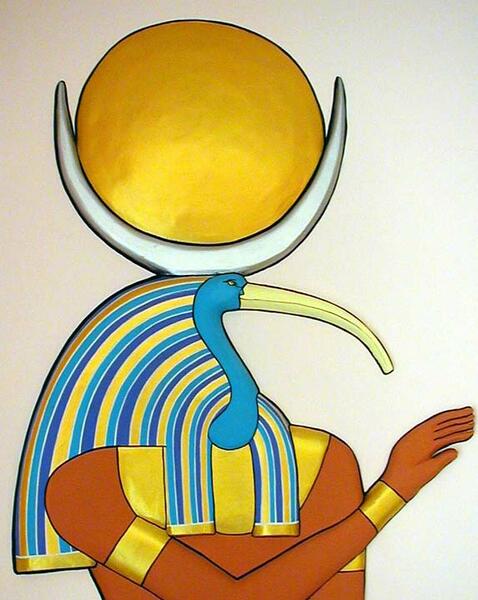 <B>Thoth Painted.</B><BR>2004
<B>Thoth Painted.</B><BR>2004
Copies of the original are cast in aqua-resin. Installed and finished. -
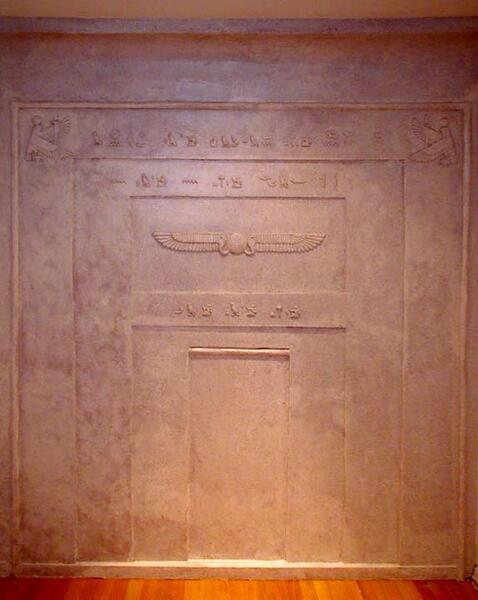 <B>A False Door</B><BR>2004
<B>A False Door</B><BR>2004
I built a replica of a False Door at the bottom of the stairs into the basement. Built of styrofoam and aqua-resin castings.
In ancient Egyptian tombs these False Doors are a common motif. Placed directly above the burial chamber it is where offerings would have been placed. The deceased would use this door to gain access to the land of the living. -
 <b>The Lotus Column</b><BR>2004
<b>The Lotus Column</b><BR>2004
The Lotus column in the foreground was also part of the project. It was made using Sonotubes which are giant cardboard tubes normally used as concrete forms. The tubes were covered with spackle to achieve a smooth surface on which to paint. The columns base and capital were made from wire mesh covered with shaped plaster. -
 <B>Scarab Sconce</B><BR>2004
<B>Scarab Sconce</B><BR>2004
<B><font color=#993300 size=+3>Paintings</font></B>
Nouveau-Pharaonic
-
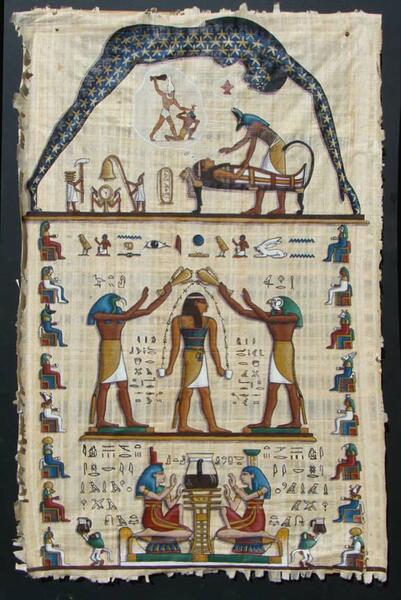 <B>The Twocupamun Papyrus</B><BR>Acrylic on papyrus<BR> 1996
<B>The Twocupamun Papyrus</B><BR>Acrylic on papyrus<BR> 1996
The hieroglyphic translation is:
Wake and smell the black medicine.
We'll brew another pot for the road. -
 <B>A Brief History of Felis Catus</B><BR>Acrylic on board<BR>1995
<B>A Brief History of Felis Catus</B><BR>Acrylic on board<BR>1995
The hieroglyphic translation is:
"Hail Double lion god! Keeper of the box.
Protector of the clay chips.
Your odor precedes you.
Sleep- play- eat- bathe- sleep
wake- bathe- play- hunt- sleep
eat- bathe- sleep- play- eat- bathe-
ACK!
Hair Ball." -
 <B>Sport of Kings</B><BR>Acrylic on board<BR>1995
<B>Sport of Kings</B><BR>Acrylic on board<BR>1995
A typical Egyptian motif will repeat color patterns. Black, yellow, green, orange, blue, red. Black, yellow, green, orange, blue, red. Just like in Croquet.
"Who's turn is it? Red, you're up."
This painting was featured on the Croquet World Online Magazine site in 1996 when the Womenâ??s World Golf Croquet Championships were held in Cairo. To tell the truth, I didn't even know the Egyptians had a team. -
 <B>Will Work for Food</B> <BR>Acrylic on Board <BR>1993
<B>Will Work for Food</B> <BR>Acrylic on Board <BR>1993
Back in the day that is exactly what you would work for. -
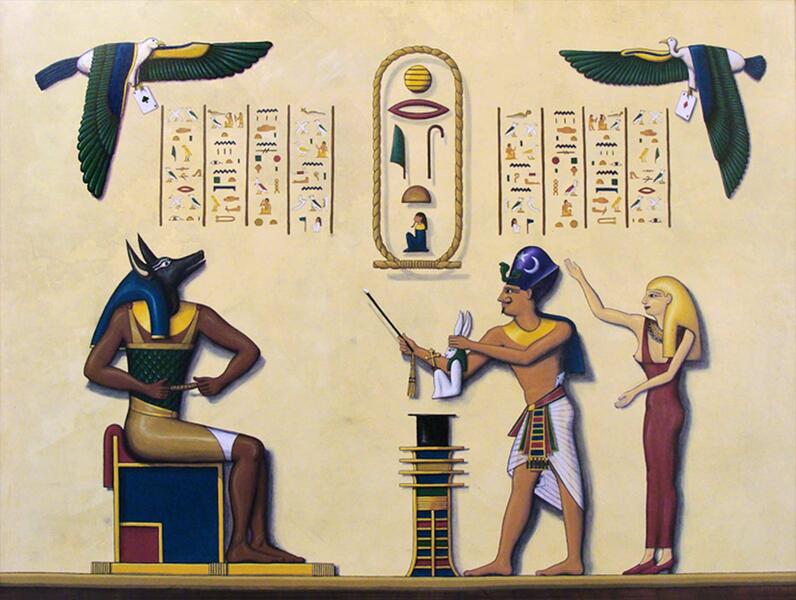 <B>Teaching an Old God New Tricks</B><BR> Acrylic on canvas<BR>1992
<B>Teaching an Old God New Tricks</B><BR> Acrylic on canvas<BR>1992
This painting was inspired by the end of the worship of the ancient gods and the introduction of Christianity. In this painting the transition is accomplished through trickery and sleight of hand.
The hieroglyphic translation reads:
The hand is quicker than the eye. Raise your eyes to heaven, put your hands together and pray to the son of a new god. -
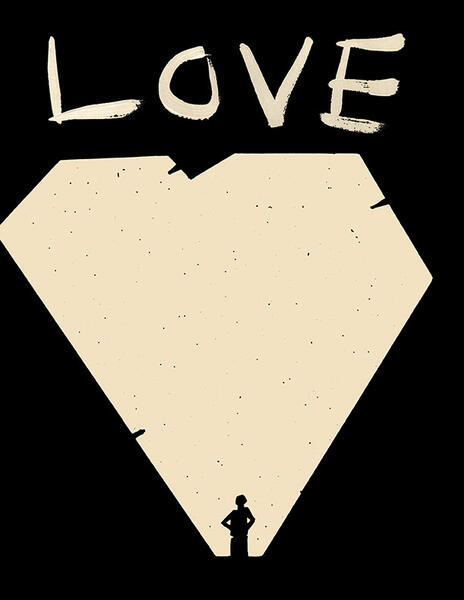 <B>Modern Art Lovers</B><BR>Acrylic on board<BR>1992
<B>Modern Art Lovers</B><BR>Acrylic on board<BR>1992 -
 <B>B.C. (Before Cable)</B><BR>Acrylic on Board<BR>1991
<B>B.C. (Before Cable)</B><BR>Acrylic on Board<BR>1991
There was a time in Egyptian history when the Greco-Roman rulers did not understand the hieroglyphic writing and became afraid of it. They believed that the picture writings on the walls would be able to come to life and hurt them. So they had their workmen cut off the arms and legs of the glyphs to avoid this situation. In this painting I imagined a world where everything is alive. The TV table has arms the Hathor columns are watching TV. I suppose, if I were a Greco-Roman ruler I might find rabbit ears a little more threatening. -
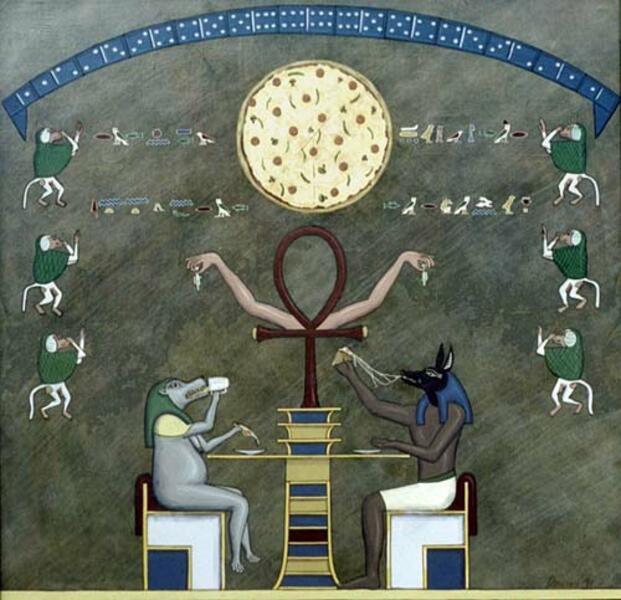 <B>Hold the Anchovies</B><BR>Acrylic on Board<BR>1991
<B>Hold the Anchovies</B><BR>Acrylic on Board<BR>1991
The hieroglyphic translation reads:
"Hold those fish, I will not eat stinky fish." -
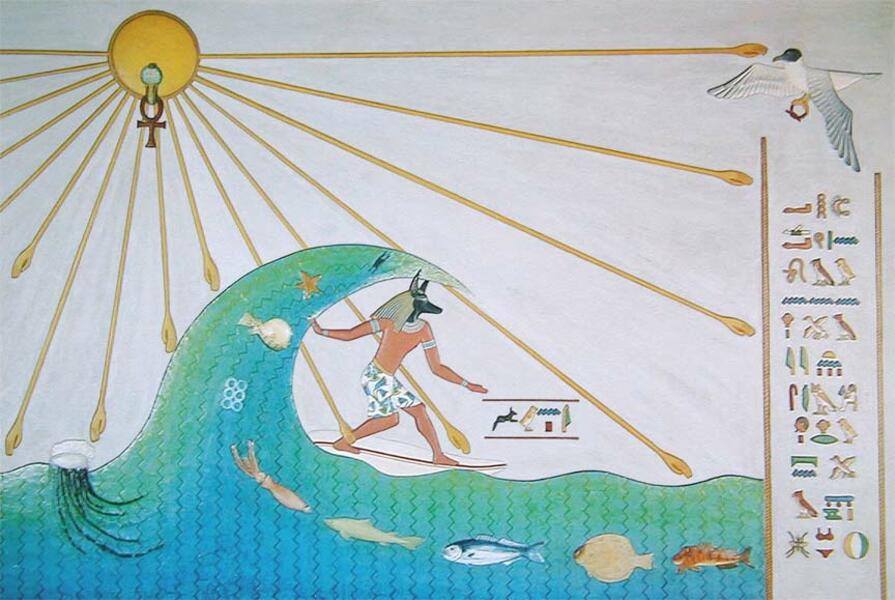 <B>Tidal Dog </B><BR>Acrylic Bas-relief<BR>1990
<B>Tidal Dog </B><BR>Acrylic Bas-relief<BR>1990
I used a mixture of spackle and gel medium. This mixture was than applied to a board to create a 1/2" thick surface for carving. I found that moistening the surface made carving easier. The gel medium kept the spackle from re-liquifying. The mixture of spackle and gel medium is a very fine surface to carve
The hieroglyphic translation reads:
"Catch a wave and you're sitting on top of the world." -
 Stone Cutter<BR>Acrylic bas-relief<BR>1990
Stone Cutter<BR>Acrylic bas-relief<BR>1990
This is one of my early bas-reliefs. Carved into about 1/2" inch of spackle on board. Although the bas-relief technique was effective and the results beautiful. It turned out to be a recipe for carpal tunnel syndrome.
The hieroglyphic translation reads:
"In gold we trust."
<B><font color=#993300 size=+2>More Paintings</font></B>
Nouveau-Pharaonic
-
 <B>T'was the Age Before Christmas</B><BR>Acrylic on board<BR>1990
<B>T'was the Age Before Christmas</B><BR>Acrylic on board<BR>1990
This is a copy of a wall fragment from the 18th dynasty. Better know as "The Inspection of Cattle." By an artist named Anonymous. This Anonymous fellow was perhaps the most prolific artist in ancient egypt. I think he is the greatest artist to have ever lived ; -)
For me, the addition of Rudolph the red-nosed reindeer hiding among the cattle brought this painting up to date. -
 <B>The First Brunch</B><BR>Acrylic on canvas<BR>1990
<B>The First Brunch</B><BR>Acrylic on canvas<BR>1990
The Last Supper has been a staple of the art world since the renaissance. But ancient Egypt was thousands of years earlier. So what came before the Last Supper? -
 <B>The Bored Room</B><BR>Acrylic on board<BR>1989
<B>The Bored Room</B><BR>Acrylic on board<BR>1989
I was working on this painting when ... Opps! An Exxon ship couldn't seem to miss Alaska. That situation was taylor made for the stone-cold stares of the members of the Bored Room.
In 1990 it was accepted into the annual juried show, Artscape. In 1992 it was one of three paintings accepted into the juried show 'Wit & Wisdom: Humor In Art', part of the annual Lucille Ball Festival in Jamestown, NY. -
 <B>Mass Transit</B><BR>Acrylic on board<BR>1989
<B>Mass Transit</B><BR>Acrylic on board<BR>1989 -
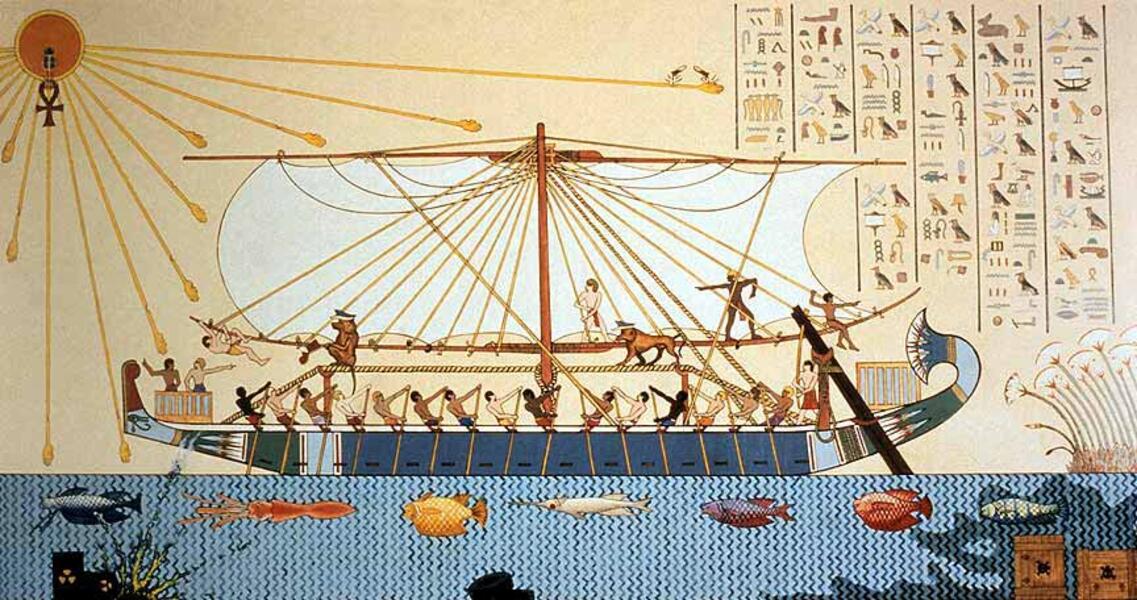 <B>Ship of Fools</B><BR>Acrylic on Board<BR>1989
<B>Ship of Fools</B><BR>Acrylic on Board<BR>1989
This painting is about the consequences of polluting our environment.
The hieroglyphic translation reads:
The ship of fools sails the poison ocean.
Corruption is their guide.
The dead harvest they will reap.
The air smells bad, the water smells bad.
The air burns my skin. -
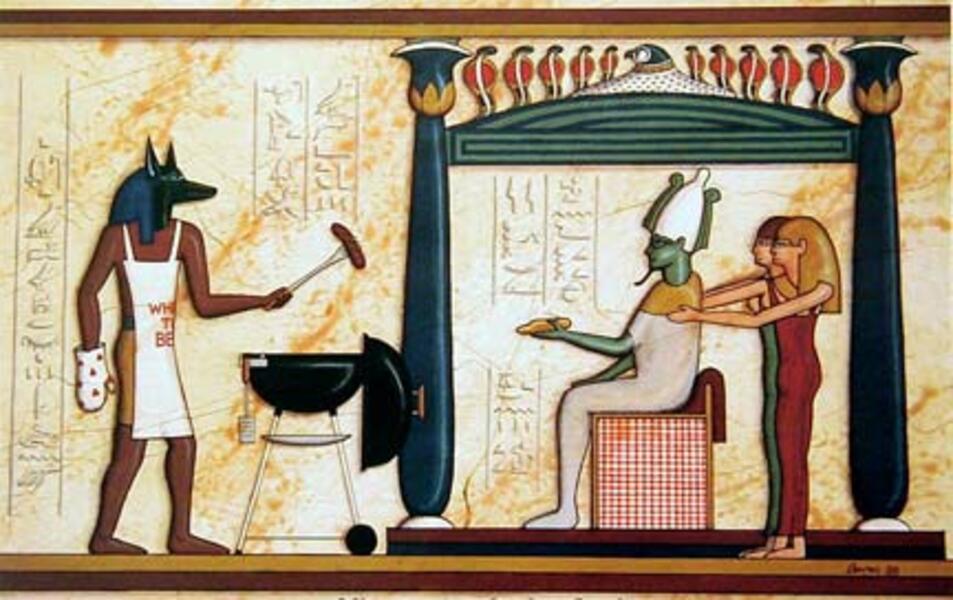 <B>Wieners of the Gods</B><BR>Acrylic on board<BR>1988
<B>Wieners of the Gods</B><BR>Acrylic on board<BR>1988
The hieroglyphic translation reads:
"Set fire to the charcoal.
Cook the dog until golden color.
Hey, give me that beer, now we eat." -
 <B>The Graceland Papyrus</B><BR>Acrylic mixed media<BR>1988
<B>The Graceland Papyrus</B><BR>Acrylic mixed media<BR>1988
I think of this as proof that Elvis is gone, standing in front of Osiris, King of the Dead. While I was researching Elvis, looking for images to help design a caricature that would be immediately recognized as the King. I found that the designs that Elvis wore were ancient Egyptian inspired. I am still not sure if the influence was on Elvis's part or wether it was a Memphis TN connection. The City the Greeks called Memphis was the first capital city in ancient Egypt.
This painting was going to be used as the catalogue cover to a show entitled Egyptomania: From Memphis to Memphis at Memphis State University's Institute of Egyptian Art and Archaeology. Unfortunately the funding was cut and the show never happened. -
 <B>Tut's Tour</B><BR>Acrylic on cast styrene<BR>1988
<B>Tut's Tour</B><BR>Acrylic on cast styrene<BR>1988
The hieroglyphic translation reads:
Having a wonderful time in the midst of America, wish you were hear. -
 <B>Rush Hour</B><BR>Acrylic on canvas<BR>1987
<B>Rush Hour</B><BR>Acrylic on canvas<BR>1987
This piece is more of a drawing than a painting. Pen and paint on canvas. When I created it I was working in a architectural model shop. This allowed me access to materials and technologies that I had not been familiar with. I was able to build templates to simplify some of the details, the street signs for instance.
The hieroglyphic translation reads:
"The time I like is the rush hour, cos I like the rush. The pushing of the people, I like it all so much. Such a mass of motion I do not know where it goes. I move with the movement and ... I have the touch." Peter Gabriel
"I wake, therefore I am."
"Wake and smell the black medicine."
"Take a break we work for the government."
"Heigh-ho, Heigh-ho. It's home from work we go." -
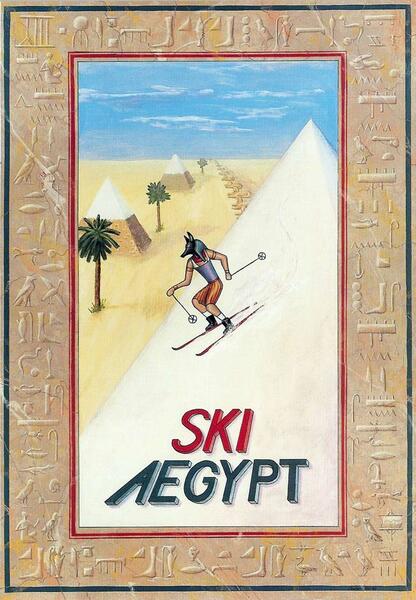 <B>Ski Ã?gypt</B><BR>Acrylic on Board<BR>1986
<B>Ski Ã?gypt</B><BR>Acrylic on Board<BR>1986
The translation of the hieroglyphs took longer to figure out than the rest of the painting. The ancient Egyptians didn't have words for things like cold or snow. So when I use the word cold it is really referring to the cool water of the Nile.
The hieroglyphic translation is:
Across the top and down the right side:
White clouds, white sky, white ground.
Be clothed in thick heavy clothing to stay warm and dry.
Down the left side and across the bottom:
I move quickly to the bottom and the cold white slope flashes before me.
Cold clouds, cold sky, cold ground.
<B><font color=#993300 size=+2>More Paintings II</font></B>
Old Favorites
-
 <B>1:47 B.C. Last Call</B><BR>Acrylic and Oil on Canvas<BR>1985
<B>1:47 B.C. Last Call</B><BR>Acrylic and Oil on Canvas<BR>1985
This is one of my first Egyptian themed paintings. In 1986 it won Honorable Mention in a juried exhibition called Humor, Wit, and Whimsy. A Maryland-National Capital Parks and Planning Commission traveling show. -
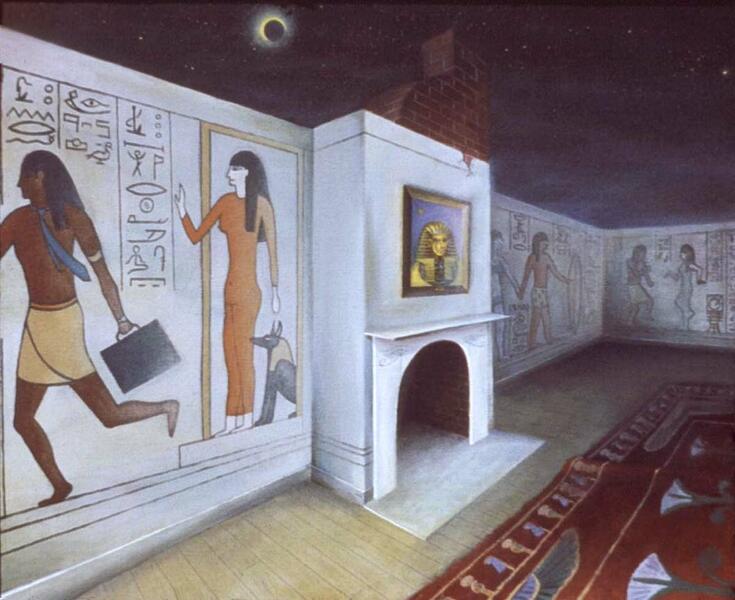 <B>Late For Work</B><BR>Oil on canvas<BR>1985
<B>Late For Work</B><BR>Oil on canvas<BR>1985 -
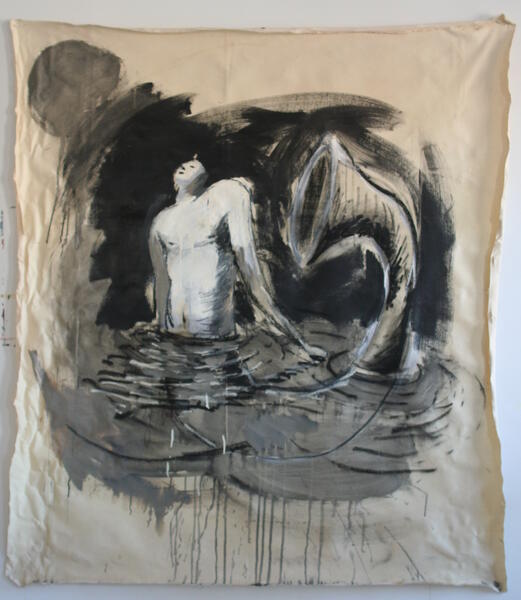 tubeoil stick and oils on canvas
tubeoil stick and oils on canvas -
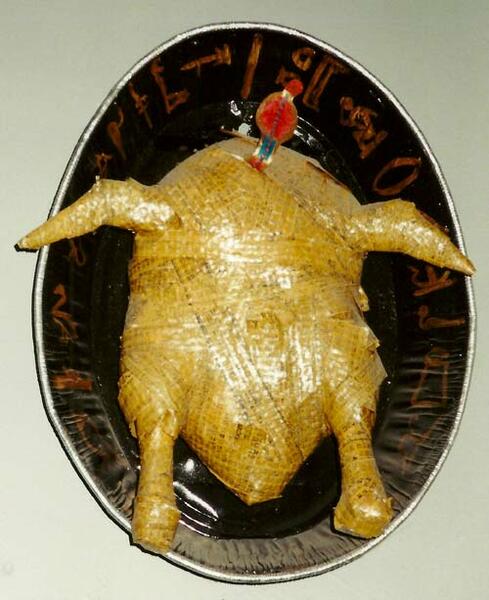 <B>Mummy-fried Chicken</B><BR>Acrylic mixed media<BR>1991
<B>Mummy-fried Chicken</B><BR>Acrylic mixed media<BR>1991 -
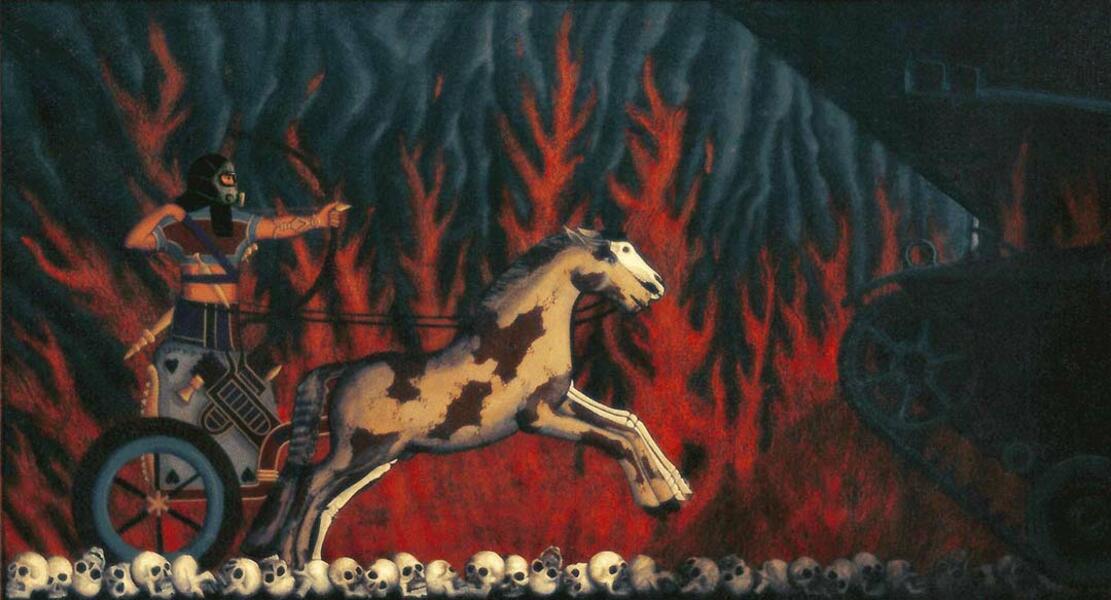 <B>Midnight at the Oasis</B><BR>Acrylic on Board<BR>1992
<B>Midnight at the Oasis</B><BR>Acrylic on Board<BR>1992 -
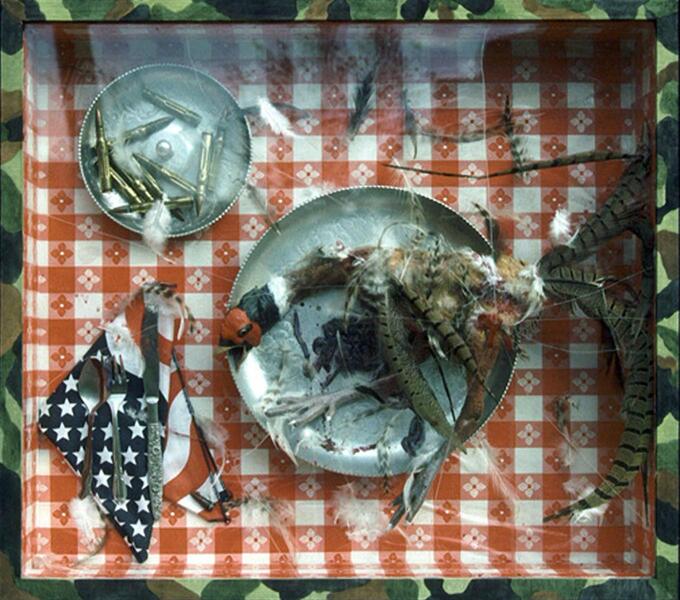 <B>Pheasant Under Glass</B><BR>Acrylic mixed media.<BR>1989
<B>Pheasant Under Glass</B><BR>Acrylic mixed media.<BR>1989 -
 <B>I Draw Breath At the Edge of Heaven</B><BR>Acrylic on Canvas<BR>1989
<B>I Draw Breath At the Edge of Heaven</B><BR>Acrylic on Canvas<BR>1989 -
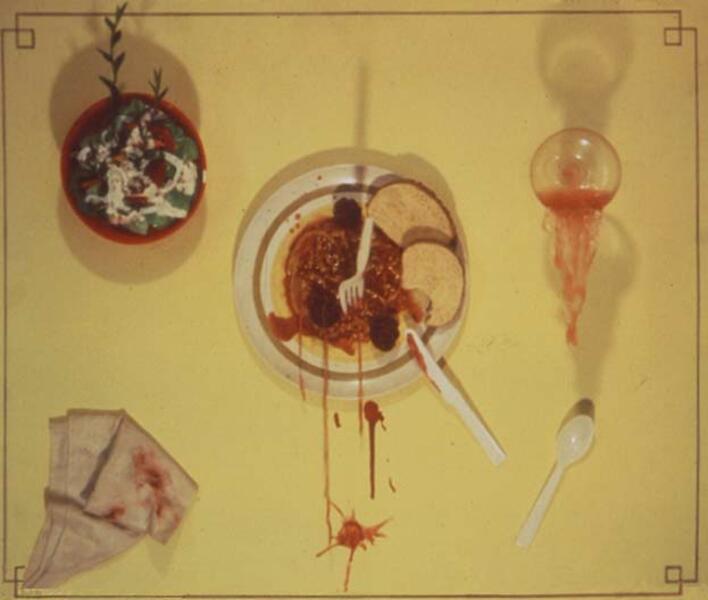 <B>Home cookin'</B><BR>Acrylic mixed media<BR>1988
<B>Home cookin'</B><BR>Acrylic mixed media<BR>1988 -
 <B>The End of the Rainbow</B><BR>Oil on Canvas<BR>1984
<B>The End of the Rainbow</B><BR>Oil on Canvas<BR>1984 -
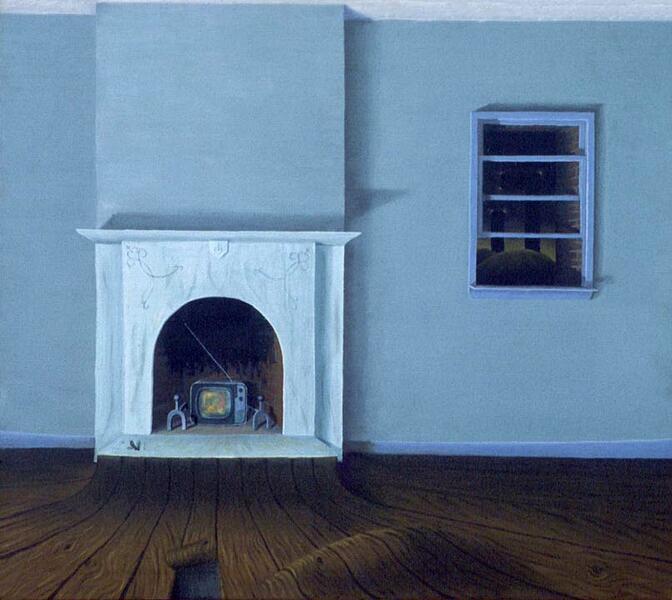 <B>It Gainth Power</B><BR>Oil on Canvas<BR>1983
<B>It Gainth Power</B><BR>Oil on Canvas<BR>1983





